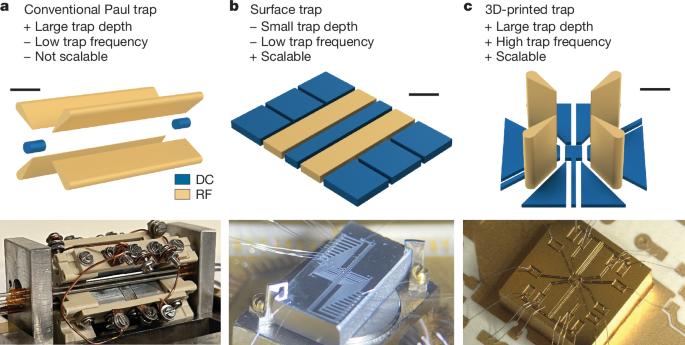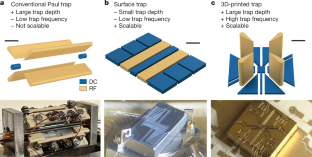3D-printed micro ion trap technology for quantum information applications
IF 48.5
1区 综合性期刊
Q1 MULTIDISCIPLINARY SCIENCES
引用次数: 0
Abstract
Trapped-ion applications, such as in quantum information processing1, precision measurements2–5, optical clocks6 and mass spectrometry7, rely on specialized high-performance ion traps. The last three of these applications typically use traditional machining to customize macroscopic 3D Paul traps8, whereas quantum information processing experiments usually rely on photolithographic techniques to miniaturize the traps and meet scalability requirements9,10. Using photolithography, however, it is challenging to fabricate the complex 3D electrode structures required for optimal confinement. Here we demonstrate a high-resolution 3D printing technology based on two-photon polymerization (2PP)11 that is capable of fabricating large arrays of high-performance miniaturized 3D traps. We show that 3D-printed ion traps combine the advantages, such as strong radial confinement, of traditionally machined 3D traps with on-chip miniaturization. We trap calcium ions in 3D-printed ion traps with radial trap frequencies ranging from 2 MHz to 24 MHz. The tight confinement eases ion cooling requirements and allows us to implement high-quality Rabi oscillations with Doppler cooling only. Also, we demonstrate a two-qubit gate with a Bell-state fidelity of 0.978 ± 0.012. With 3D printing technology, the design freedom is greatly expanded without sacrificing scalability and precision, so that ion trap geometries can be optimized for higher performance and better functionality. High-resolution 3D printing technology making use of two-photon polymerization instead of traditional machining is described, allowing low-cost and scalable production of large arrays of high-quality 3D Paul traps.


量子信息应用的3d打印微离子阱技术
捕获离子的应用,如量子信息处理、精密测量、光学时钟和质谱分析,都依赖于专门的高性能离子阱。后三种应用通常使用传统加工来定制宏观3D保罗阱8,而量子信息处理实验通常依赖光刻技术来使阱小型化并满足可扩展性要求9,10。然而,使用光刻技术,制造最佳约束所需的复杂3D电极结构是具有挑战性的。在这里,我们展示了一种基于双光子聚合(2PP)11的高分辨率3D打印技术,该技术能够制造大型高性能小型化3D陷阱阵列。我们表明,3D打印离子阱结合了传统加工3D阱的优点,如强径向约束和片上小型化。我们在3d打印的离子阱中捕获钙离子,径向阱频率范围从2兆赫到24兆赫。严格的约束简化了离子冷却要求,使我们能够仅通过多普勒冷却实现高质量的拉比振荡。此外,我们还演示了一个贝尔态保真度为0.978±0.012的双量子比特门。利用3D打印技术,在不牺牲可扩展性和精度的情况下,大大扩展了设计自由度,因此离子阱几何形状可以优化,以获得更高的性能和更好的功能。
本文章由计算机程序翻译,如有差异,请以英文原文为准。
求助全文
约1分钟内获得全文
求助全文
来源期刊

Nature
综合性期刊-综合性期刊
CiteScore
90.00
自引率
1.20%
发文量
3652
审稿时长
3 months
期刊介绍:
Nature is a prestigious international journal that publishes peer-reviewed research in various scientific and technological fields. The selection of articles is based on criteria such as originality, importance, interdisciplinary relevance, timeliness, accessibility, elegance, and surprising conclusions. In addition to showcasing significant scientific advances, Nature delivers rapid, authoritative, insightful news, and interpretation of current and upcoming trends impacting science, scientists, and the broader public. The journal serves a dual purpose: firstly, to promptly share noteworthy scientific advances and foster discussions among scientists, and secondly, to ensure the swift dissemination of scientific results globally, emphasizing their significance for knowledge, culture, and daily life.
 求助内容:
求助内容: 应助结果提醒方式:
应助结果提醒方式:


